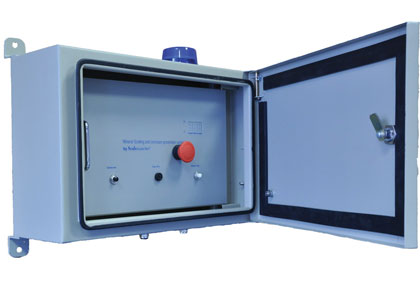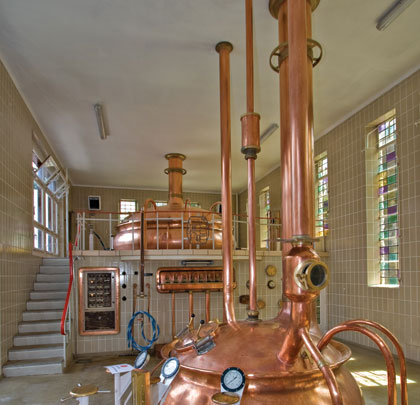Beer contains 90 percent water, and it is the most important ingredient in determining its flavor. Water contains calcium and is the most important mineral to the brewing process. The levels of calcium in local water have determined the type of beer produced. The different types of beer whether a light lager or a porter are for the most part due to the water profiles of the areas that made the styles famous.
Calcium is by far the most influential mineral in the brewing process. It reacts with phosphates, forming precipitates that involve the release of hydrogen ions and in turn lowers the pH of the mash. Calcium is the principal mineral of hardness, which increases mash acidity and inverts malt phosphate. It stimulates enzyme activity and improves protein digestion. Calcium also extracts the fine bittering principles of the hop. However, although calcium is the most important ingredient in brewing beer it also has a negative effect on brewing equipment as it creates beerstone and limescale.
BEERSTONE
Beerstone is calcium oxalate that appears in mash kegs, boiling kegs, tanks and lines. The precipitate is largely due to the reaction between alkaline cleaners (caustic), hard water minerals (calcium and magnesium) and protein. If not completely removed in the cleaning process, beerstone leaves an unhygienic surface that can harbor microorganisms. An unhygienic surface will infect the beer. Beerstone can cause “off flavors” or shorten the shelf life of beer. In the worst case scenario, undesirable organisms can ruin an entire batch of beer, costing time and money to replace.
LIMESCALE
Although calcium is an essential ingredient in beer production it also creates limescale, which has a negative effect on heat exchangers, reverse osmosis (RO), pipes and vessels used in the brewing industry. Over time, limescale will gradually build up, progressively reducing the efficiency of heat transfer of equipment, blocking water lines and increasing fuel costs. Deposits are an insulating layer on heat transfer surfaces. It is estimated that 40 percent more energy is needed to heat water in a system fouled with ¼ inch (6.35 millimeters) of limescale. This leads to more power being consumed or to the installation of heavier duty, more expensive heat exchangers to compensate.
Although beerstone is primarily derived from calcium oxalate and limescale from calcium carbonate, both are caused through precipitation and scaling which are mostly caused through the heating of water solutions. Within this environment Electronic water conditioners, such as Scalewatcher, are the ideal solution for removing and preventing the RO membranes being clogged with scale. As Electronic water treatment (EWT) changes the shape of the molecules from rough to smooth, they do not form a matted structure and are washed away thereby preventing the membranes from being clogged which in turn reduces maintenance shutdown and energy costs.
SUPER SATURATION
Aqueous solutions can become supersaturated, which means that they contain higher concentrations of dissolved solute than their equilibrium concentration. Such solutions are not stable and are easily triggered into dropping back to saturation level, forcing the dissolved compound to precipitate. Even when a bulk solution is less than fully saturated, scale formation can occur spontaneously due to localized super saturation, at a surface for example.

pH EFFECT ON SCALE FORMATION
The pH of the solution is directly related to its acid content (typically carbonic acid). The higher the acid content, the lower the pH value. The solubility of calcium carbonate is directly affected by the pH of the water. If the pH of the water is decreased, more calcium carbonate solid can be dissolved. Conversely, if the pH of the water rises, it will force calcium carbonate out of solution and hence scale deposits will form.
TEMPERATURE EFFECT ON SCALE FORMATION
Gases in general, and specifically carbon dioxide, are less soluble in water at high temperatures. There is an equilibrium between CO2 (the gas) and H2CO3 (carbonic acid) in water, which depends very much on temperature. With the rising temperature, H2CO3 decomposes and—with Ca-ions in the solution—CaCO3-crystals are formed from the solution. As less carbonic acid is there, the pH increases (i.e. from 7.5 to 8).
PRESSURE EFFECTS ON SCALE FORMATION
Carbon dioxide and gases in general are more soluble under higher pressure. Therefore, as the pressure drops, carbon dioxide gas will be forced out of solution, lowering the carbonic acid concentration. The rise in pH is associated with a drop in calcium carbonate solubility, leading to the formation of mineral scale deposits.
ELECTRONIC WATER CONDITIONING
EWT is a non-invasive system utilizing a solenoid coil or coils wrapped around the pipework to be treated. A continuously frequency changing signal generator, within a specified range, supplies current to the coils. The pulse shaped current creates an induced electric field, concentric around the axis inside the pipe. As a consequence to this arrangement, any charged particle or ion moving within the field experiences a so-called Lorentz force generated by the interaction between charged particles and magnetic and electric fields.
The treatment influences the initial nucleation, resulting in crystals that do not “stick” together. Untreated water builds up matted structures that continuously grow. This treatment creates idiomorphic, scattered crystals, which do not form matted structures. They have a rotundas shape, which means that they have a larger volume in relation to a smaller surface. This feature makes them sensitive to water (beer) currents and they are easily flushed out of the pipeline. As no new scale layers are formed, the sheer force of the water flow will gradually remove existing layers of scale. The ability to adjust power, frequency and coil configurations of products like the Scalewatcher on site enables performance to be optimized with no downtime and no pipe replacement.
Recent laboratory research has shown that EWT fields are effective in suppressing biofilm development and removing biofilm if it is already present. The research also found a clear relationship between developing bacterial colonies and pipe material, plastic material being the worst. As combined biofilms/scale-structures are often found together and support each other, removal has to deal with both elements. The laboratory testing showed that EWT does not only have an impact on biofilms, but also softens the scale. So it is gradually broken up thus removing the support structure for the biofilms. The technology gradually breaks down the combined scale/biofilms-structure and its components, which are progressively flushed away by the water (beer) flow. ■
About the Author
Jan de Baat Doelman is president of Scalewatcher North America Inc. The Scalewatcher is an environmentally friendly alternative to chemical and mechanical descaling. Launched in the 1980s it has successfully treated hard water problems for industrial manufacturers as well as water companies, oil producers, farmers, horticulturists, shipping companies, shopping centers, school, universities and government establishments. For more information, call 610.932.6888, email sales@scalewatcher.com, or visit www.scalewatcher.com.
MODERN PUMPING TODAY, October 2014
Did you enjoy this article?
Subscribe to the FREE Digital Edition of Modern Pumping Today Magazine!


